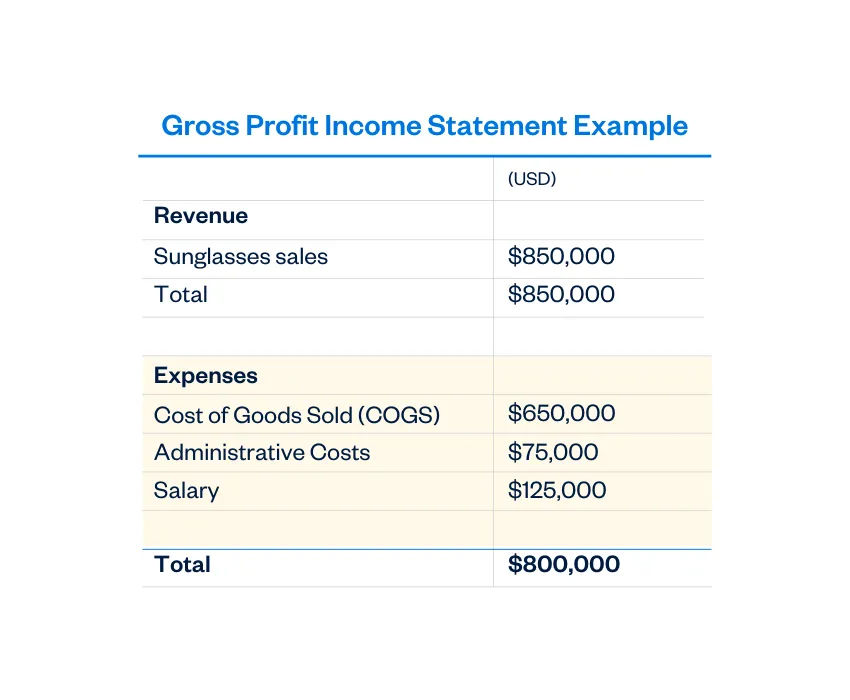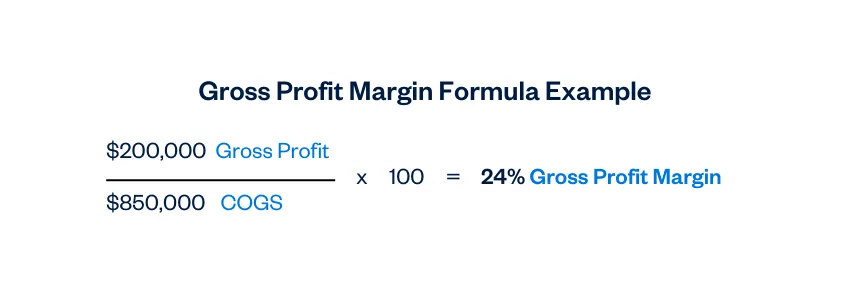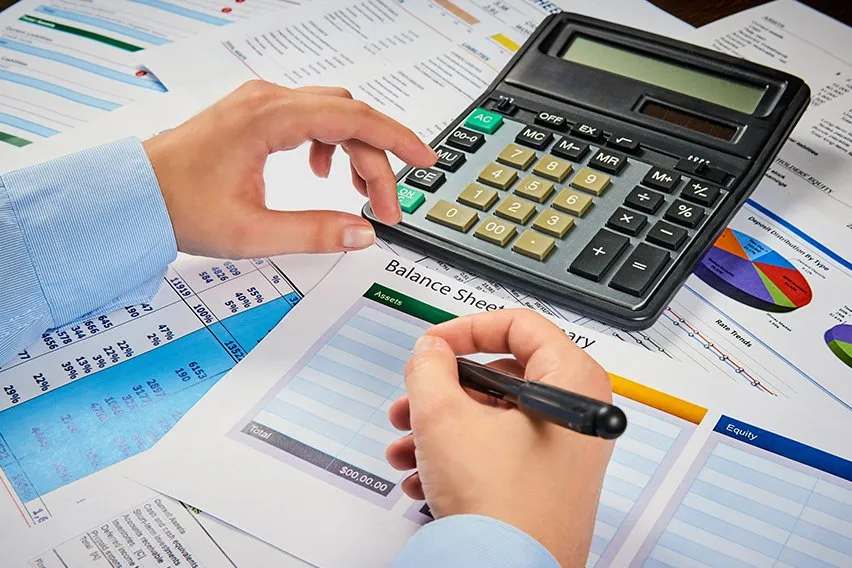How to Find Gross Profit: Definition and Calculation

Gross Profit (also known as sales profit or gross income) is the profit a company has left over after paying all direct expenses related to the manufacturing and selling of its products—or, if it’s a service-based business, providing its services to customers.
You can find Gross Profit on a company’s income statement, and it’s calculated by subtracting the cost of goods sold (COGS) from the company’s total sales revenue.
In formula form:
Gross Profit = Revenue – Cost of Goods Sold (COGS)
Gross Profit Margin is an important metric for small businesses. In this article, we’ll cover the ins and outs of Gross Profit, including:
What Is the Formula for Gross Profit?
How Do You Calculate Gross Profit Margin?
Why Is Gross Profit Important?
What’s the Difference Between Net Profit and Gross Profit?
PLEASE NOTE: FreshBooks Support team members are not certified income tax or accounting professionals and cannot provide advice in these areas, outside of supporting questions about FreshBooks. If you need income tax advice please contact an accountant.
What Is Gross Profit? (Just the Basics)
The gross profit of a business is also known as its gross income. Gross profit is defined as a business’s profits after subtracting the cost of goods sold (COGS) from the company’s total revenue.
Here are a few key points to understand about gross profit:
- Gross profit is a metric used to determine how effective a company is at manufacturing and delivering its products and/or services. The higher the gross profit, the more efficiently a company is leveraging its resources.
- Gross profit is calculated by subtracting the cost of goods sold (COGS) from total revenue.
- Generally, only variable costs are considered in COGS when calculating gross profit. Variable costs are those directly involved with output (like material and shipping costs). Fixed expenses (like rent and insurance) do not factor into gross profit.
What Is the Formula for Gross Profit?
As the name suggests, the gross profit formula is the formula for calculating a company’s gross profit.
The gross profit formula is:

Let’s break down each element of the Gross Profit formula even further.
Revenue
Revenue is the amount of money generated from sales of a company’s products and/or services during a specific time period (for example, a month or a quarter), before any deductions.
The total dollar amount a company brings in from selling their products and/or services is their revenue.
Cost of Goods Sold
Cost of goods sold (or COGS) are the direct costs a company has associated with the production of a product and/or service (also known as production costs).
Some examples of these costs include:
- Depreciation
- Factory overhead
- Labor costs directly related to production (for example, wages for hourly factory workers)
- Materials
- Storage
- Sales-related fees (for example, feed on customers’ credit card purchases)
- Packaging and shipping
- Sales-related commissions
One important thing to note: COGS does not include fixed costs or expenses, which need to be paid regardless of production/output.
Fixed costs that don’t factor into COGS include:
- Marketing and advertising
- Labor costs not directly related to production (for example, executive salaries)
- Administrative costs
- Rent
- Insurance
- Office supplies
- Software
- Amortization
- Depreciation
- Dues
- Equipment leases
- Interest charges on loans
- Property Taxes
- Subscriptions
- Utilities
The Gross Profit Formula in Action
Now let’s jump into a gross profit formula example.
Garry’s Glasses is a manufacturer of high-end sunglasses headquartered in San Diego. Garry’s sunglasses are shipped to a variety of retailers all over the state of California. The company has been in business for one year—and, as such, it’s time for Garry to do his year-end finances and calculate the gross profit for this first year in business.
The first step of the process? Calculating the company’s revenue. Again, this is the total amount of money Garry’s Glasses made from the sales of their products—before any deductions (like the costs associated with manufacturing sunglasses). After reviewing his sales, Garry determines the company’s revenue for the year is $850,000.
Next up? Calculating COGS (cost of goods sold). This includes all of the costs Garry incurred in manufacturing and selling his sunglasses—including production labor, material costs, and shopping. After reviewing his expenses for the year, Garry determines his COGS is $650,000.
Using the gross profit formula, Garry can calculate his gross profit as follows:

When Garry subtracts the company’s COGs from its revenue, he ends up with a gross profit of $200,000 for the year.
Let’s see what this might look like if Garry was using his company’s income statement to calculate gross profit:

To determine gross profit, Garry would subtract COGS ($650,000) from his total revenue ($850,000). For the purposes of gross profit, he would ignore the administrative and salary costs on his company’s income statement. These are fixed costs and, as such, aren’t included in the gross profit formula.
How Do You Calculate Gross Profit Margin?
Once you understand the gross profit formula and how to calculate gross profit, the next step is understanding how to determine gross profit margin. Gross profit margin (also known as gross margin) is simply gross profit, expressed as a percentage.
The gross profit margin formula breaks down as follows:

In the case of Garry’s Glasses, calculating Gross Margin would break down as follows:

As you can see, the gross profit margin for Garry’s Glasses’ first year of business is 24%.
Why Is Gross Profit Important?
Understanding how to calculate Gross Profit is fairly straightforward. But it’s also important to understand why calculating Gross Profit matters for businesses.
Gross Profit is important for a company’s accounting because it gives them a clear way to measure how efficiently they are producing their products or services. If a company has a high Gross Profit, they’re making efficient, profitable decisions around their production costs (or cost of goods sold), like purchasing supplies and allocating production-related labor. If their gross profit is low (or negative), they may need to rethink their approach to production—and look to cut their costs of goods sold in order to get their Gross Profit into the green.
What’s the Difference Between Net Profit and Gross Profit?
Gross Profit and Net Profit are two important metrics for a company to understand. But while they may sound similar, they have one key difference.
Gross Profit is the income a business has left after paying all their variable costs directly related to the manufacturing of their products and/or services (cost of goods sold). Net Profit is the income a business has left after deducting all of their expenses from a company’s revenue—including the fixed costs that are excluded from Gross Profit (like rent or insurance).
So essentially, Gross Profit measures the profitability of a company’s production and manufacturing processes—while Net Profit measures the company’s profitability as a whole. Bottom line? Gross Profit and Net Profit (as well as Gross Profit Margin and Net Profit Margin) are both important—but different—metrics.
Last Word: Why You Need The Gross Profit Formula
The Gross Profit Formula is important because it gives business owners a metric to determine the efficiency—and the profitability—of their production processes. Understanding how the costs associated with manufacturing their product relates to their revenue allows them to identify potential areas where they can cut costs and increase the profitability of their company’s production—which ultimately, will increase their profitability as a company.
About the author
Deanna deBara is an entrepreneur, speaker, and freelance writer who specializes in business and productivity topics. When she's not busy writing, she enjoys exploring the Pacific Northwest with her husband and dog. See more of her work and learn more about her services at deannadebara.com.
RELATED ARTICLES

 How to Calculate Total Assets: Definition & Examples
How to Calculate Total Assets: Definition & Examples Forecasting a Balance Sheet | The Small Business Guide to Financial Forecasts
Forecasting a Balance Sheet | The Small Business Guide to Financial Forecasts What Is an Intangible Asset? A Simple Definition for Small Business (With Examples)
What Is an Intangible Asset? A Simple Definition for Small Business (With Examples) What Is Straight Line Depreciation?
What Is Straight Line Depreciation? Auditing: Definition, Types, and Importance
Auditing: Definition, Types, and Importance What Is Depreciation?
What Is Depreciation?